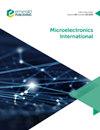具有聚苯胺/ PEO-ZnO纳米纤维传感层的化学敏感型氨气传感器
IF 0.8
4区 工程技术
Q4 ENGINEERING, ELECTRICAL & ELECTRONIC
引用次数: 0
摘要
目的研究聚苯胺/聚氧化物(PANI/PEO)和聚苯胺/聚氧化物/氧化锌(PANI/PEO- zno)复合纳米纤维在室温下的氨传感性能。设计/方法/方法使用微加工技术制造气体传感器结构。首先,在二氧化硅晶片上通过热蒸发法制备金电极。采用静电纺丝法制备PANI/PEO纳米纤维,并利用射频磁控溅射在静电纺丝纳米纤维上沉积ZnO层作为传感层。采用傅里叶变换红外光谱(FTIR)、扫描电镜(SEM)和x射线衍射对纳米纤维的分析进行表征。最后,在室温条件下,利用实验装置对PANI/PEO和PANI/PEO/ZnO纳米纤维进行气敏分析。此外,还积极研究了湿度(17%-90% RH)对传感器电阻的影响。FTIR分析证实了PANI、PEO和ZnO在纳米纤维结构中存在官能团。SEM显微照片显示,ZnO对静电纺PANI/PEO纳米纤维的贡献是无珠、更薄、光滑的纳米纤维。此外,根据气敏结果,PANI/PEO纳米纤维的响应时间和恢复时间分别为115 s和457 s。而PANI/PEO/ZnO纳米纤维的响应时间和恢复时间分别为245 s和153 s。PANI/PEO/MOx复合纳米纤维由于具有高的表面/体积比和降低气体传感器对湿度的依赖,确保了气体传感器对nh3气体的稳定性,使气体传感器对环境更加稳定。在本研究中,采用射频磁控溅射技术在PANI/PEO纳米纤维上沉积氧化锌,以研究和提高PANI/PEO/ZnO和PANI/PEO复合纳米纤维对氨的传感器响应和恢复时间,而不是原位聚合。这些结果表明ZnO可以提高导电聚合物基电阻传感器的传感性能。本文章由计算机程序翻译,如有差异,请以英文原文为准。
A chemosensitive-based ammonia gas sensor with PANI/PEO–ZnO nanofiber composites sensing layer
Purpose This study aims to investigate the ammonia-sensing performance of polyaniline/polyethylene oxide (PANI/PEO) and polyaniline/polyethylene oxide/zinc oxide (PANI/PEO-ZnO) composite nanofibers at room temperature. Design/methodology/approach Gas sensor structures were fabricated using microfabrication techniques. First, onto the SiO 2 wafer, gold electrodes were fabricated via thermal evaporation. PANI/PEO nanofibers were produced by the electrospinning method, and the ZnO layer was deposited by using radio frequency (RF) magnetron sputtering on the electrospun nanofibers as a sensing layer. Fourier transform infrared spectroscopy (FTIR), scanning electron microscopy (SEM) and X-ray diffraction were performed to characterize the analysis of nanofibers. After all, gas sensing analysis of PANI/PEO and PANI/PEO/ZnO nanofibers was conducted using an experimental setup at room temperature conditions. Furthermore, the impact of humidity (17%–90% RH) on the sensor resistance was actively investigated. Findings FTIR analysis confirms the presence of functional groups of PANI, PEO and ZnO in nanofiber structure. SEM micrographs demonstrate beads-free, thinner and smooth nanofibers with ZnO contribution to electrospun PANI/PEO nanofibers. Moreover, according to the gas sensing results, the PANI/PEO nanofibers exhibit 115 s and 457 s response time and recovery time, respectively. However, the PANI/PEO/ZnO nanofibers exhibit 245 s and 153 s response time and recovery time, respectively. PANI/PEO/MOx composite nanofibers ensure stability to the NH 3 gas owing to the high surface/volume ratio and decrease in the humidity dependence of gas sensors, making gas sensors more stable to the environment. Originality/value In this study, ZnO was deposited via RF magnetron sputtering techniques on PANI/PEO nanofibers as a different approach instead of in situ polymerization to investigate and enhance the sensor response and recovery time of the PANI/PEO/ZnO and PANI/PEO composite nanofibers to ammonia. These results indicated that ZnO can enhance the sensing properties of conductive polymer-based resistive sensors.
求助全文
通过发布文献求助,成功后即可免费获取论文全文。
去求助
来源期刊

Microelectronics International
工程技术-材料科学:综合
CiteScore
1.90
自引率
9.10%
发文量
28
审稿时长
>12 weeks
期刊介绍:
Microelectronics International provides an authoritative, international and independent forum for the critical evaluation and dissemination of research and development, applications, processes and current practices relating to advanced packaging, micro-circuit engineering, interconnection, semiconductor technology and systems engineering. It represents a current, comprehensive and practical information tool. The Editor, Dr John Atkinson, welcomes contributions to the journal including technical papers, research papers, case studies and review papers for publication. Please view the Author Guidelines for further details.
Microelectronics International comprises a multi-disciplinary study of the key technologies and related issues associated with the design, manufacture, assembly and various applications of miniaturized electronic devices and advanced packages. Among the broad range of topics covered are:
• Advanced packaging
• Ceramics
• Chip attachment
• Chip on board (COB)
• Chip scale packaging
• Flexible substrates
• MEMS
• Micro-circuit technology
• Microelectronic materials
• Multichip modules (MCMs)
• Organic/polymer electronics
• Printed electronics
• Semiconductor technology
• Solid state sensors
• Thermal management
• Thick/thin film technology
• Wafer scale processing.
 求助内容:
求助内容: 应助结果提醒方式:
应助结果提醒方式:


